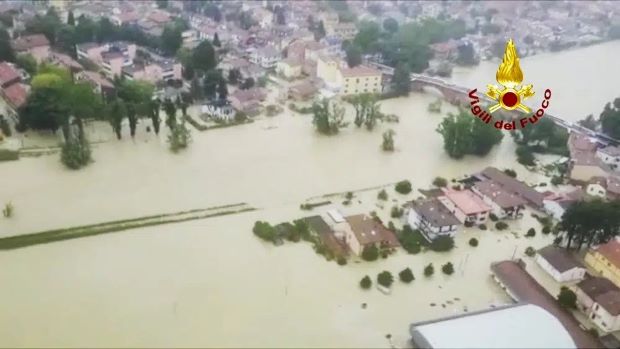‘Catastrophic’ floods in Italy leave 8 dead and thousands homeless

By Elisabetta Povoledo
ROME — Widespread flooding in the northern Italian region of Emilia-Romagna killed at least eight people and forced another 5,000 to abandon their homes, officials said Wednesday (17) as rescue efforts continued to assist those stuck on the upper stories of buildings.
Some of the worst-hit areas received almost 20 inches of rain in 36 hours, about half the average annual amount, according to the Italian civil protection minister, Nello Musumeci.
Taking into account those figures, “you can understand how powerful this rainfall was,” he said.
Stefano Bonaccini, regional president of Emilia-Romagna, said that the rainfall had been a “catastrophic event that has never been registered before.” His deputy, Irene Priolo, said Wednesday that the death toll had risen to eight people.
Scenes of dramatic rescues from flooded towns have dominated national news broadcasts over the past two days: helicopters airlifting residents from the roofs of homes submerged in water; rescue workers wading through chest-high waters carrying older people on their backs; volunteers in rubber dinghies transporting residents from their homes as belongings floated from open doors.
Schools were shuttered, trains in the region were cancelled, and roads and highways were closed as waters swept over large areas of land, submerging fields and some towns.
Priolo said that at least 23 rivers in Emilia-Romagna — including the Savio, the Montone, the Santerno and the Lamone — had burst their banks, affecting some 36 towns. Local officials were working to evacuate those in danger, a note on the region’s website said.
Paride Antolini, president of the geologists’ guild of Emilia-Romagna, called the rainfall — which averaged almost 8 inches across the region in less than 48 hours — “unprecedented.”
The rains in recent days followed a storm two weeks ago that had already saturated the area, damaging and eroding many riverbanks.
The storm this week led to dozens of landslides in hilly areas and severe flooding in the plains, while rough seas battered coastal areas of the region, Antolini said. “In this moment, we’re facing millions in damages” to homes, agriculture, bridges and roads, he noted.
“There’s a lot of work that must be done,” he added. “This has been a huge catastrophe.”
Flooding is a complex phenomenon with many causes, including land development and ground conditions, scientists say. While linking the climate crisis to a single flood event requires extensive analysis, the human-caused changes, which are already leading to heavier rainfall in many storms, are an increasingly important part of the mix. Warmer atmosphere holds, and releases, more water, whether in the form of rain or heavy winter snowpack.
The record rainfall that led to devastating floods in Germany and Belgium in the summer of 2021 was made much more likely by global warming, scientists have determined. Climate change also probably worsened extreme rains during back-to-back storms in southeastern Africa in early 2022, experts say, although a lack of high-quality weather data for the region has made it difficult to pin down how much.
Antolini said that extreme weather events — including heavy rainfalls — had become increasingly common in his region.
“Scientific references say we are heading toward climate change, so it’s time to start thinking about the actions that we should be doing,” he said. “We have to learn from these situations.”
Musumeci, the civil protection minister, said that the decision to evacuate thousands of people from flood-hit areas was essentially “a preventive measure.”
Speaking during a radio interview, he added, “It is clear that a much more careful reconnaissance” had to be done on levees and hydraulic systems to deal with the recurring impact of heavy rains that, in the past few years, have followed long periods of drought.
“It’s clear that we have to adopt a very different approach than what we were used to,” he said.
A Formula 1 motor race that was to have been held in the Emilia-Romagna region was cancelled because of the rains and flooding.
In a statement Wednesday, the organizers said, “The decision has been taken because it is not possible to safely hold the event for our fans, the teams and our personnel and it is the right and responsible thing to do given the situation faced by the towns and cities in the region.”
“It would not be right to put further pressure on the local authorities and emergency services at this difficult time,” the statement added.
Heavy rains fell on other areas of Italy on Wednesday. Officials in one small town near Florence, in central Italy, were considering plans to evacuate the population after landslides cut off access, the Italian news agency ANSA reported.
On Tuesday (16), Venice, in northeastern Italy, activated its flood control system, a series of gates, but the city has not been affected by the flooding so far.
-New York Times


Comments are closed, but trackbacks and pingbacks are open.